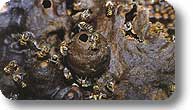 |
Ciénaga de Zapata National Park |
Typical Products |
|
|
|
 |
In March the citrus fruits plantations of Jaguey Grande blossom and beekeepers place the beehives in these areas. Besides producing honey, bees guarantee the uniform pollination of the cultivations. At the end of it, the beehives are moved to Ciénaga and remain there for the rest of the year. The most used species in these "transhumance" systems is Apis melliphera. In Ciénaga di Zapata there is another species, called stingless bee (Mellipona sp.). It is a local endemic species and its honeycombs can be frequently found in the fissures of the tree trunks. Characterized by the absence of sting, it is used at a family level also by children, it produces less honey than the other species, but of higher quality, since it has medicinal properties and is used to treat eye pathology. |
Craftsmanship |
|
| Clay working dominates, for the production of pots, ornaments, and tools for domestic use. Often the handicrafts represent the various species of the autochthonous fauna and are purchased both by local population and visitors. Workers are mainly women; the most expert women teach to the young ones, so that they can learn the technique and secrets of clay manipulation. |